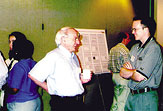
Center for Design of Analog-Digital Integrated Circuits (CDADIC)
Washington State University (lead institution)
A National Science Foundation Industry/University Cooperative Research Center since 1989
Partner Institutions:
- University of Washington
- Oregon State University
- State University of New York at Stony Brook
Mixed analog-digital circuitry enhances performance in electronic systems and allows for greater miniaturization of products

|
Center Mission and Rationale
Analog-digital integrated circuits are used in a growing number of fields, including avionics, space technology, medical electronics, and wireless communications. The telecommunication industry's demand for mixed-signal circuits capable of high-speed, high-resolution, and low-power performance is rapidly expanding and continues to challenge researchers in the field. Since its inception in 1989, the Center for Design of Analog-Digital Integrated Circuits (CDADIC) has focused on the problems associated with mixed-signal circuitry and systems. Today, the Center is one of the few university-led research efforts in the country dedicated to designing chips capable of using this technology and has gained an international reputation in the field.
The mission of CDADIC is to advance the analysis, design, and methodologies of analog-digital integrated circuits and systems through research and education. The Center is a consortium of four universities (Washington State University, University of Washington, Oregon State University, and State University of New York at Stony Brook) and approximately 30 industry partners. Over the last decade, CDADIC has made significant progress toward giving the electronics and semiconductor industries access to analog-digital design technology that is reliable and effective.

|
Research Program
The Center's primary research goals are to: 1) Achieve global recognition by providing international leadership in mixed-signal integrated circuits and systems research and 2) Establish an integrated research program focused on the long-term research necessary to develop and advance future technologies and short-term research relevant to current industry needs. To achieve its goals, CDADIC focuses on three major research areas:
- Circuit Design -- Developing new mixed-mode circuit designs for high-precision, low-voltage, and high-speed applications
- Design Methodology -- Developing systematic methods for design that incorporate the reuse of existing designs, module generation, and automatic layout of analog-digital integrated circuits
- Modeling/Simulation -- Constructing accurate computer models of circuits, devices, and interconnects as well as developing methodologies to evaluate, test, and characterize new and existing circuit simulators and/or improve speed and efficiency for analog-digital simulation.
Through its many projects, CDADIC has transferred important technologies to industry. Some of the Center's research currently used by industry includes:
- The Boeing Company is now using CDADIC research to develop high-speed A/D converters and power control ICs for its customers, including developing technology for NASA applications.
- New lateral and vertical DMOS models from the Center have been transferred to Standard Microsystems Corp., Northrop Grumman, and Texas Instruments.
- A vertical power MOSFET model, a discrete BJT model, and support work for older MOS and bipolar models were transferred to Avant! (formerly Analogy) and implemented into the company's Saber's MAST language and SPICE.
- AMI is currently using substrate noise coupling models for mixed-signal design as well as high-frequency design developed by Center researchers.
- CDADIC's mixed-mode transceiver circuits developed in a 0.35 µm single-poly CMOS process are being used by Lucent and are available to consumers using Design Framework II.
- AMI, Analog Devices, and Burr-Brown are using the Center's Matlab toolbox for delta-sigma converters.

|
Patenting rights also are available to CDADIC industry partners. The Center has obtained patents in the areas of logic family, analog BiCMOS, current-mode, and switched-current designs.
Special Center Activities
In addition to its research activities, CDADIC has served as a catalyst for broadening educational and outreach opportunities for university members and its industry partners that include:
- Enhancing educational opportunities for students by offering new and updated university courses and providing them with state-of-the art computer and laboratory facilities
- Offering students significant practical experiences through hands-on laboratory experience, internships with member companies, and other student-industry interactions
- Participating in innovative educational programs such as Research Experiences for Undergraduates and Research at Undergraduate Institutions
- Partnering with institutions abroad in research and outreach activities, such as CDADIC's work with the Technical University of Budapest, sponsored by an NSF Eastern Europe Cooperative Science grant
- Collaborating with other Industry/University Cooperative Research Centers (I/UCRCs).
- Providing industry members access to specialized faculty skills and in-person research reviews and consultation.
Center Headquarters
Center for Design of Analog-Digital Integrated Circuits
Washington State University
College of Engineering and Architecture
P.O. Box 642780
Washington State University
Pullman, WA 99164-2780
Tel (509) 335-5593 * Fax (509) 335-7290
Homepage: www.eecs.wsu.edu/CDADIC/
Center Director: John Ringo, Ph.D.
ringo@wsu.edu
Co-director: Carl Sechen, Ph.D.
sechen@ee.washington.edu
Co-director: Un-Ku Moon, Ph.D.
moon@ece.orst.edu
Co-director: Adrian Leuciuc, Ph.D.
aleuciuc@sunysb.edu
Center Evaluator: Craig Scott
(206) 543-2259 * scottcs@u.washington.edu
NSF 01-168d